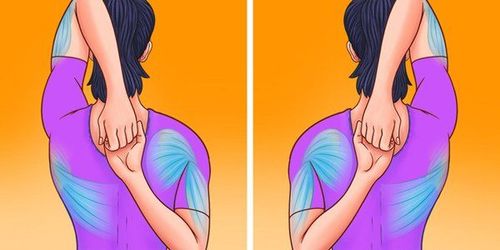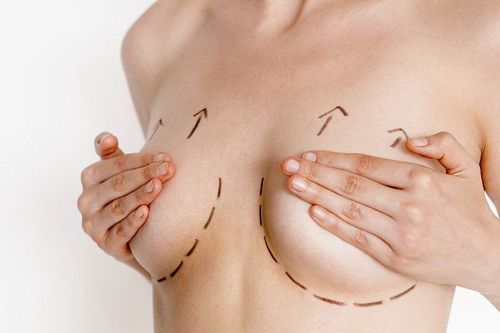This is an automatically translated article.
Shoulder pain is a condition in which a person has stiffness and pain in the shoulder and is unable to raise the arm above the head. It limits range of motion and causes pain when trying to move. You have pain, stiffness in the shoulder area and wonder "Can massage, massage and stretching help relieve neck and shoulder pain?". Here are 10 massages and stretches for sore, stiff shoulders that will help you.1. Stiff shoulder syndrome
Stiff shoulder syndrome occurs when the mobility of the shoulder joint is limited to such an extent that it causes pain. The limited range of motion of the shoulder joint makes it difficult to perform certain movements and causes pain when trying to move. Shoulder pain can also be caused by an inflamed and constricted shoulder capsule.To regain your ability to function, you must develop an effective treatment plan involving stretching and massage. You should use massage and stretching as well as acupressure to treat this condition. However, it is advisable to consult a doctor or physiotherapist.
If you have pain that persists and interferes with daily activities, see your doctor to diagnose your condition. They will ask about your symptoms, previous injuries, and any activities that worsen your condition.
The doctor can observe your active and passive range of motion. Usually, they will be able to diagnose your condition based on your signs and symptoms. If needed, they will do imaging tests such as X-rays, MRIs, or ultrasounds to rule out other causes. A decision will then be made on whether or not you need physical therapy.
2. The benefits of massage and stretching for painful, stiff shoulders
Shoulder joint massage and stretching are extremely beneficial for treating neck and shoulder pain.Massage helps to relieve muscle tension and contractures. This helps restore mobility and improve function. It can also help improve blood flow to the affected area and reduce inflammation. Stretching improves flexibility, increases range of motion, and lengthens muscle fibers. Both of these treatments can ease pain and discomfort. Doing this makes you feel more comfortable doing your daily activities.

Mát-xa vai giúp dịu cơn đau và sự khó chịu vùng vai
3. Treatment goals for stiff shoulder syndrome
A stiff painful shoulder—technically known as adhesive bursitis—is a common condition that causes stiffness, pain, and discomfort in your shoulder joint. It happens when the range of motion of your shoulder joint is reduced to the point where it feels like your shoulder is frozen.Stiff shoulder usually affects people between the ages of 40 and 70. It is caused by inflammation, repetitive motion, or prolonged periods of inactivity. Being sedentary while you're being treated for an illness, procedure, or injury can also be a cause. Or sometimes it's not clear what the cause is.
At first, the symptoms of this syndrome are mild but gradually become more severe. Due to discomfort and loss of range of motion, people with stiff shoulder tend to use the shoulder less, which further reduces mobility.
Not using your shoulder for a period of time worsens your symptoms, so it's important to keep your shoulder mobile. Massaging and stretching can increase your range of motion and reduce pain.
4. 10 massages and stretches for sore, stiff shoulders
4.1. Use the foam roller to massage under the arm
Place a foam roller under your affected arm. Place your arms on the floor. Lengthen your arms. Gently roll back and forth on the foam roller. Continue for up to 1 minute.4.2. Shoulder massage with sponge roller
Place a foam roller under your affected arm. Lengthen your arm, keeping the hand of your affected arm extended upwards. Roll over and over again4.3. Simple self-massage
Use the opposite hand to massage the affected shoulder and arm. Concentrate on any sensitive areas. Gently move your affected arm as you massage the shoulder and arm. Or you can use electronic massagers to improve mobility and reduce stress. Focus on painful areas and trigger points (Myofascial trigger points in the shoulder muscles and surrounding areas can cause a stiff shoulder. Trigger points are muscle nodes, lumps, or sensitive areas that can cause pain. They can be caused by injury, overactivity, or by pain in another area of the body. They can cause pain, reduced mobility, and muscle weakness. Trigger points can also lead to weeks. poor completion and spasm).4.4. Swing pendulum
Do the move with a light dumbbellIn a standing position, place your unaffected hand on the edge of a table or chair. Lean forward slightly and place your affected arm along your body. Swing your arms forward and backward. Then rotate it from side to side. Swing your arms in circles in both directions. Do each movement 10 times.
4.5. Horizontal body stretch
From a standing position, place the hand of the affected arm on the opposite shoulder. Use your opposite hand to gently press the affected elbow toward the body. Hold this position for a few seconds. Repeat 5 times.4.6. Push umbrella
Sit in a chair with your elbows along your body. Use the umbrella handle to hold the umbrella in front of you. Use your unaffected arm to push your affected arm to the side. Keep the elbow of your affected arm pulled toward you. Return to the starting position. Repeat 5 times.4.7. Stretch your hands behind your back
This stretch requires you to move more, so you may not be able to do it right away.From a standing position, place your affected arm behind your back. Use the opposite hand to grasp this wrist. Gently stretch your affected arm by moving it toward the opposite hip. Gently move it as far as possible Hold this position for a few seconds. Repeat 5 times.

Cách mát xa vai giúp thư giãn và giảm căng cứng
4.8. Stretch towel
From a standing position, use both hands to hold the towel (curled lengthwise) horizontally behind your back. Use your opposite arm to pull your affected arm upwards. Stretch and lengthen the muscles in your affected shoulder and arm. Hold this position for a few seconds. Repeat 5 times.4.9. Advanced towel stretch
Place the towel over your unaffected shoulder and hold the top of the towel. Use your affected arm to hold the bottom of the towel. Gently pull it down towards your lower back. Hold this position for a few seconds. Repeat 5 times4.10. Stretch according to the reach of the body
Sitting or standing, place your unaffected hand on your affected elbow. Draw your affected arm over your body. Use gentle force to lift elbows and stretch shoulders. Hold the pose for 20 to 30 seconds. 5 Repeats Above are a few types of exercises for Stiff Shoulder Syndrome that you can refer to, but remember to consult your doctor before exercising to choose the right exercise method and Avoid injuries caused by poor posture. Before performing the stretch, you need to exercise your shoulder muscles by warming up your body. You can do this by taking a warm bath. Or use a heating pad on the affected area. Stretch to the point you feel it without causing pain. Do these movements gently and avoid forcing any of them.Be active during your recovery and be patient as it can take several months to fully recover from a frozen shoulder.
Please dial HOTLINE for more information or register for an appointment HERE. Download MyVinmec app to make appointments faster and to manage your bookings easily.
Reference source: healthline.com












